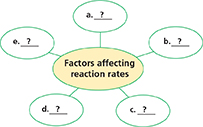7.4 Reaction Rates
Reading Focus
Key Concept
 What does a reaction rate tell you?
What does a reaction rate tell you? What factors cause reaction rates to change?
What factors cause reaction rates to change?
Vocabulary
reaction rate
catalyst
Reading Strategy
Building Vocabulary
Copy the partially completed web diagram at the right. Then, as you read, complete it with key terms from this section.

Figure 20 A cyclist burns the Calories in a banana faster than a person walking would. But burning the banana outside the body would release the energy of the banana even faster.

You may have heard of athletes “burning Calories” when they exercise. A Calorie is a unit of energy used in the field of nutrition. The average banana, for instance, contains about 100 Calories. The cyclist in Figure 20 can use up, or burn, as many as 10,000 Calories during the course of a race. That adds up to a lot of bananas!
If you eat a banana, you provide your body with about 100 Calories to burn. This energy is released in a series of reactions that take place inside your body. A much faster way of releasing the energy contained in a banana is to burn it—outside the body—in a combustion reaction. In both cases, the total amount of energy released is the same. However, the time it takes for the energy to be released is different in each case.
Reactions Over Time
The progress of any chemical reaction can be measured over time.
Different reactions have different durations. Some reactions, such as the explosion of TNT, happen almost instantaneously. Other reactions, such as tree leaves changing color during autumn, happen gradually.
Any change that happens over a period of time can be expressed as a rate. For example, speed is the rate that distance changes over time. A reaction rate is the rate at which reactants change into products over time.  Reaction rates tell you how fast a reaction is going. That is, how fast the reactants are being consumed, how fast the products are being formed, or how fast energy is being absorbed or released.
Reaction rates tell you how fast a reaction is going. That is, how fast the reactants are being consumed, how fast the products are being formed, or how fast energy is being absorbed or released.




